April 2024 Issue Table of Contents
Plate reconstructions of oceanic domains are generally based on paleomagnetic and seafloor spreading records. However, uncertainties associated with such reconstructions grow rapidly with increasing geological age because the original oceanic plates have been subducted. Here we synthesize advances in seismic tomographic mapping of subducted plates now lying within the mantle that assist plate reconstructions. Our proposed Japan–NW Pacific subduction histories incorporate tomography results and show three distinct stages comparable to those revealed by geochronology, petrology, and geochemistry. We propose major revisions to previously accepted ideas about the age, kinematics, and identity of the plates outboard of Japan during the Cretaceous–Paleogene Sanbagawa-Ryoke paired metamorphism. These revisions require updates to relevant plate convergence boundary conditions and thermo-dynamic models.
1811-5209/24/0020-0103$2.50 DOI: 10.2138/gselements.20.2.103
Keywords: Subduction; Pacific; Izanagi; magmatism; tomography; mantle
INTRODUCTION
Japan has been situated along an active subduction zone since the Cretaceous and probably earlier (Fig. 1A, 1B; e.g., Taira 1988; Maruyama et al. 1997; Isozaki et al. 2010). However, many details of Japan–NW Pacific plate tectonic histories remain debated. Reconstructing the plate tectonic history of any subduction zone is a challenge because subduction zones are sites where the most robust plate tectonic constraints (i.e., marine magnetic anomalies and transform faults) are consumed and lost into Earth’s mantle. As such, plate reconstructions of subduction zones typically show uncertainties that grow rapidly with increasing geological age. Here we synthesize recent results using seismic tomography to map subducted plates (i.e., slabs) now lying within the mantle and reconstruct Japan–NW Pacific plate tectonics since the Cretaceous. We compare our “tomographic” plate model against largely independent geochemical studies of arc magmatism throughout Japan and surrounding regions and develop an integrated surface–mantle plate tectonic reconstruction. Finally, we discuss links between Sanbagawa met a morphism (Fig. 2A) and magmatic activity with the plate kinematics, thermal regime, and identity of the plates outboard of Japan at the time.
RECONSTRUCTING JAPAN–NW PACIFIC PLATE TECTONIC HISTORY
The Pacific plate offshore of Japan shows Mesozoic seafloor ages that progressively young towards the NNW before terminating at the trench (Fig. 1A). Global plate reconstructions based on seafloor spreading restore the present Pacific seafloor near Japan eastwards into the central Pacific during the Late Cretaceous, thousands of kilometers away from its present location (Fig. 1C). A very large (>6000 km) reconstruction gap is formed between Japan and the Pacific plate during the Late Cretaceous, with similarly large unknown regions along the entire NW Pacific during this time (Fig. 1C). These plate tectonic uncertainties are among the largest on Earth for the Mesozoic and Cenozoic eras, and Pacific realm plate tectonic histories are considered the most challenging to reconstruct during this period.
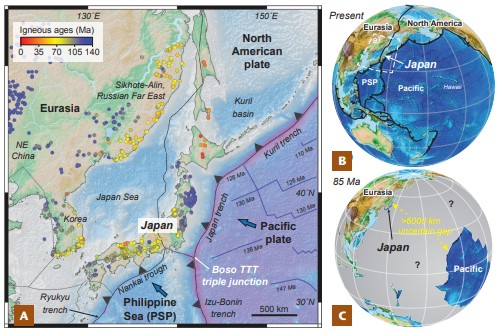
Published Japan–NW Pacific plate reconstructions attempt to fill the uncertain gaps using various geological or geophysical inferences; however, these models show contrasting plate kinematics (i.e., plate convergence rates and obliquity), plate geometries, and even differ on the identity of past subducting oceanic plates. For example, published plate models disagree on whether the Kula plate, the Izanagi plate, or other unnamed backarc basins or oceanic plates were subducted along Japan during the Cretaceous to present (e.g., Maruyama et al. 1997; Seton et al. 2015; Itoh et al. 2017; Wu et al. 2022a). Of particular importance is the lack of agreement on reconstructed spreading ridge subduction events during the Cretaceous to early Cenozoic; proposals include trench-orthogonal to trench-parallel ridge-trench intersections at different times (e.g., Maruyama et al. 1997; Seton et al. 2015; Itoh et al. 2017; Wu and Wu 2019; Kimura et al. 2019). The current diversity of proposed Japan plate reconstructions and ridge-trench intersections are problematic because they imply very different geological contexts, subducting plate ages, and thermal regimes during the Sanbagawa and Ryoke metamorphic events in the Cretaceous (e.g., Wallis et al. 2009; Yamaoka and Wallis 2023).
Back in Time: Reconstructing Japan–NW Pacific Plate Tectonics
Today, Japan is situated at the complex intersection of four tectonic plates: the Eurasian, North American, Pacific, and Philippine Sea plates (Fig. 1A, 1B). An offshore trench-trench-trench (TTT) triple junction to the south of Japan named the “Boso TTT” marks the intersection of the Japan, Nankai, and Izu-Bonin trenches (Fig. 1A). Along the Japan-Kuril sections, the Pacific plate subducts WNW under the Eurasia–North America continent, whereas along the Shikoku-Ryukyu trench, the Philippine Sea plate subducts WNW beneath Eurasia. South of the Boso TTT, the Pacific plate subducts under the Philippine Sea along the Izu-Bonin trench to form an intra-oceanic subduction zone. Subduction of both the Philippine Sea and the Pacific plates near Japan has probably been established since the Miocene 20 to 15 Ma (e.g., Kimura et al 2014).
To go back in time, the Japan Sea backarc basin should be suitably “closed” (i.e., reverse the kinematics of its extensional opening) to place the Japanese islands back to their former position along eastern Eurasia prior to rifting and backarc spreading in the Miocene (i.e., “pre-rift Japan”). Unfortunately, it remains debated whether the Japan Sea opened as a saloon-style “double door”, a broad pull-apart basin, or in some other fashion (Fig. 2B–2D; van Horne et al. 2017). Still, for the purposes of a plate reconstruction, the hundreds of kilometers in uncertainties between Japan Sea models are small compared with extensive gaps (>6000 km) in reconstructing the subducted oceanic plates (Figs. 1C and 2E). In this study, we restore the Cretaceous Japan-Eurasian margin following a model that considers both Japan Sea double-door opening and ~500 km left-lateral fault offset along the Eurasian margin based on geological continuity (Fig. 2D; Yamakita and Otoh 2000). Other reconstructions are possible, and we use the ~20° azimuthal differences in proposed orientations of the pre-rift Japan islands (Fig. 2B–2D) to estimate uncertainty. The uncertainty in the pre-Miocene orientation of the Japanese islands most significantly affects our ability to reconstruct Japan–NW Pacific plate convergence angles back in time because these angles are sensitive to the orientation and shape of the reconstructed Japan-Eurasian continental margin. However, subducted oceanic plates are a much larger source of uncertainty. Mantle seismic tomography can help throw light on the nature of these lost plates (Fig. 1C).

Insights from Mantle Tomography
Figure 3 shows a composite tomographic transect across the East Asian mantle under Japan. We attempt to optimize imaging tradeoffs by superimposing a higher-resolution tomography model FWEA18 that has restricted regional and depth coverage (Tao et al. 2018) on global tomography GAP-P4 that has wider coverage (Fukao and Obayashi 2013; Fig. 3). The transect shows three main groups of fastvelocity anomalies (blue colors in Fig. 3) that we identify as the following subducted oceanic lithospheric remnants (i.e., slabs) consistent with previous studies (Seton et al. 2015; Liu et al. 2017; Wu et al. 2022b): (1) the Pacific slabs from the surface to ~1100 km depths; (2) the Izanagi slabs from ~1300 to 2000 km depths; and (3) older subducted slabs below ~2300 km depths to the core–mantle boundary. A fourth key feature is the prominent slow-velocity “slab gap” between 1000 to 1250 km depths under the Ordos basin, China (Fig. 3). The slab gap is a 4000-km-long, laterally continuous, NE–SW trending anomaly that is seen within the East Asian mantle (e.g., Fig. 3; Seton et al. 2015; Wu et al. 2022b). Other tomography models generally show similar first-order features to those in Figure 3 (e.g., Wu et al. 2022b).
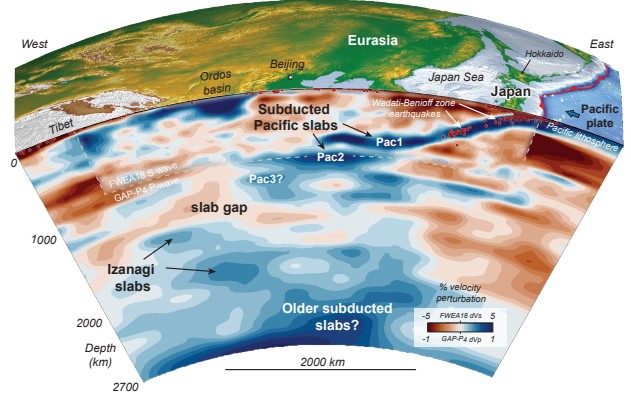
The west-dipping Pacific slabs are revealed by WadatiBenioff earthquakes (red spheres in Fig. 3) and accompanying fast-velocity anomalies Pac 1 within the uppermost ~600 km mantle and deeper anomalies Pac2 and possibly Pac3 that extend ~2000 km westwards below Eurasia to regions under Beijing, China (Fig. 3). We “unsubduct” the Pacific slabs by structurally restoring their cross-sectional slab areas to a pre-subduction ocean lithospheric thickness using area conservation (Wu et al. 2022b). For the Figure 3 transect, the slab anomalies Pac1 and Pac2 account for a total length of ~4900 ± 1200 km of subducted Pacific Ocean lithosphere; the uncertainties include consideration of cross-sectional slab areas from alternative tomographic images (Wu et al. 2022b). Adding the deeper Pac3 slabs would increase the unsubducted slab lengths by <10% (~400 km), which is within uncertainty. In either case, the unsubducted Pacific slabs can fill most if not all of the >6000-km-long plate reconstruction gap between the Pacific plate and Japan back to the Late Cretaceous (e.g., Fig. 1C).
Crucially, input of our structurally restored Pacific slabs into a quantitative plate reconstruction reveals that Pacific subduction under Japan and surrounding areas (i.e., Korea, NE China, Sikhote-Alin) began around 50 ± 10 Ma (Wu et al. 2022b); extrapolation of the present Pacific seafloor ages near Japan (Fig. 1A) implies the Pacific plate near Japan at that time was very young. These results imply subduction of a trench-parallel Izanagi-Pacific mid-ocean ridge along Japan at 50 ± 10 Ma (Wu et al. 2022b). Our restored western Pacific plate and Izanagi-Pacific spreading ridge geometry then allows us to recreate the lost Izanagi plate as its “twin” (i.e., conjugate rift flank; Wu et al. 2022b).
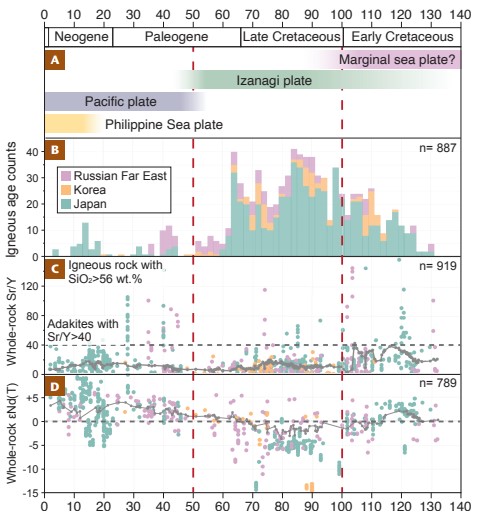
The slower-velocity “slab gap” at 1000 to 1300 km depths under the present Ordos basin (Fig. 3) is reproduced by forward geodynamic models that incorporate trenchparallel subduction of the Izanagi-Pacific spreading ridge 50 ± 10 Ma (Seton et al. 2015; Wu et al. 2022b), which lends support to our reconstruction. In these models, the slab gap was formed by subduction of a warm spreading ridge, and the gap marked the transition between shallower Pacific slabs to the east and deeper Izanagi slabs to the west (Seton et al. 2015; Wu et al. 2022b). The Izanagi slabs in Figure 3 are identified on this basis.
The Izanagi slabs at 1300 to 2000 km depths under Japan (Fig. 3) account for westward subduction under Japan from the early Cenozoic ~50 Ma to the mid-Cretaceous ~100 Ma (Wu et al. 2022b; Lin et al. 2022), or Jurassic (Seton et al. 2015). Deeper slabs imaged within the mantle at depths below ~2300 km likely record subduction before the mid-Cretaceous. Although their interpretation is less straightforward, forward geodynamic models and tomographic studies suggest that backarc basins and intra-oceanic subduction zones formed offshore of Japan prior to 85 or 100 Ma (van der Meer 2012; Lin et al. 2022). Such ideas are supported by geological studies of subduction complexes in Hokkaido, Japan (Ueda and Miyashita 2005). Despite some uncertainty prior to 105 ± 20 Ma, we provisionally reconstruct marginal sea subduction along Japan, with the Izanagi plate subducting offshore of Japan along an intra-oceanic subduction zone (Figs. 4 and 5A).
LINKING JAPAN SUBDUCTION HISTORY FROM TOMOGRAPHY TO NE ASIAN ARC MAGMATISM
In most regions of the Earth, subduction produces arc magmatism. During subduction, release of volatiles (e.g., H2O and CO2) from a subducting plate lowers the melting point of nearby solid mantle rocks; the resulting melt rises buoyantly towards the surface. Therefore, arc magmatic spatiotemporal patterns provide a test of subduction histories independent from tomography. The chemical composition of arc magmatism may also provide additional insights on the nature of subduction. Here we compare our tomography-derived NE Asian plate tectonic history (Fig. 4A) to the 140 to 0 Ma magmatic record of Japan and the surrounding area synthesized from published igneous rock geochronology and geochemistry (Fig. 4B–4D). As with all natural systems, there is data bias towards better sampled regions like SW Japan but sampling distribution maps (not shown here) show adequate regional coverage overall (e.g., Fig. 1A).
Northeast Asian magmatic histories reveal three main episodes characterized by distinct geochemical compositions and magmatic fluxes based on igneous age counts (Fig. 4B–4D): (1) magmatism from ~135 to 100 Ma shows moderate fluxes, adakitic signatures with elevated average Sr/Y ratios of 27.8 that are distinct from typical arc magmatism, and relatively depleted εNd isotopic compositions that average 0.0 (see brief explanation of εNd in Fig. 4 caption); (2) magmatism between 100 to 50 Ma shows the highest fluxes, the lowest average Sr/Y ratio of 11.0, and relatively isotopically enriched compositions (average εNd of –4.6); and, (3) magmatism younger than 50 Ma shows the lowest magmatic flux, an average Sr/Y ratio of 19.5, and isotopically depleted compositions (average εNd of +2.6). Igneous age counts are susceptible to sampling bias but the change from higher to lower fluxes after ~50 Ma is consistent with NE Asian magmatic areal addition rates (Wu and Wu 2019) and the trend is opposite to expected preservation bias.
The three distinct episodes of magmatism identified above correlate with our Japanese margin plate-tectonic periods from tomography (colored bars in Fig. 4A): (1) a transition period between ~135 to 100 Ma when subduction of marginal sea(s) along Eurasia terminated and Izanagi subduction began (green and red bars in Fig. 4A); (2) a ~100 to 50 Ma period of Izanagi subduction along Eurasia (green bar in Fig. 4A); and (3) Pacific subduction along Eurasia from ~50 Ma to present (blue bar in Fig. 4A). The elevated Sr/Y magmatism from 135 to ~100 Ma (Fig. 4C) coincides with the time of initiation of Izanagi subduction along the Japanese margin or just before. Among the possible origins for high Sr/Y magmatism, we consider subducted slab melting due to elevated thermal conditions during a plate reorganization or partial melting of deep, thickened crust during intra-oceanic arc accretion as our preferred mechanisms. A 56 to 46 Ma magmatic hiatus (Fig. 4B) along the Japanese arc has been linked to Izanagi-Pacific ridge subduction (Wu and Wu 2019; Yamaoka and Wallis 2023). The significant increase in εNd after 56 to 46 Ma (Fig. 4D) has been related to infiltration of isotopically depleted sub-slab mantle into the mantle wedge across an IzanagiPacific slab window during ridge subduction (Wu and Wu 2019). Japan magmatism may also show a response to the ~23 to 15 Ma Japan Sea opening, with a flare-up (Fig. 4B) and a wider distribution in εNd(T) isotopic values from −5 to +10 in contrast to the 50 to 20 Ma εNd(T) that are generally between 0 to +5 (Fig. 4D). More widely spread Nd isotopic values imply that the magmatism had multiple sources including depleted mantle and enriched continental crust under the regional thermal conditions during Japan Sea opening. After ~15 Ma, Japan magmatism shows mixed signals from the modern configuration of Philippine Sea plate subduction along the Nankai trough and Pacific plate subduction along the Japan trench (Fig. 1).
Figure 5 shows schematic maps and cross sections incorporating our Japan-NW Pacific plate reconstructions and information on magmatism.
IMPLICATIONS FOR SANBAGAWA METAMORPHISM, JAPAN
The Sanbagawa metamorphic belt spans the Kyushu, Shikoku, and SW Honshu islands of Japan before disappearing offshore to the east (Fig. 2A). The well-studied, coarse-grained, eclogite-bearing lithology of the Sanbagawa belt, central Shikoku, shows a distinct metamorphic stage at ~120 Ma followed by the dominantly observed and most widespread stage of metamorphism at ~90 Ma that we herein call the “main metamorphism” (Fig. 6E; Endo et al. 2012). Counterclockwise pressure–temperature (P–T) paths are recorded at ~120 Ma, whereas the Sanbagawa main metamorphism at ~90 Ma shows clockwise P–T paths (Fig. 6F). In other words, the Sanbagawa belt contains units that were heated at ~120 Ma, isobarically cooled (i.e., fixed at the upper plate), then experienced another temperature rise at ~90 Ma, followed by cooling and exhumation. The counterclockwise P–T paths are interpreted to reflect a phase of “hot” subduction initiation at ~120 Ma, followed by transition to a colder, steady-state subduction zone. Similar counterclockwise P–T paths were also reported at the Cretaceous-aged Kamuikotan metamorphic belt in Hokkaido (Fig. 2A), suggesting a common subduction initiation around 120–130 Ma along the paleo-Japan arc (Takeshita et al. 2023).
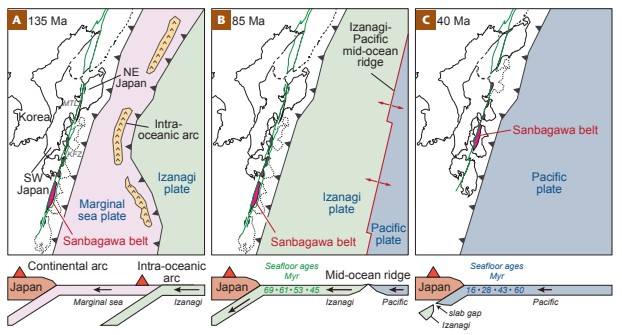
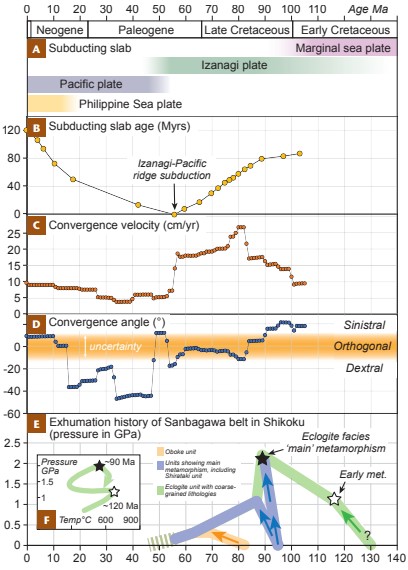
Our plate model and magmatic analyses support a change in subduction boundary conditions along the Japanese margin around 105 ± 20 Ma that we ascribe to Izanagi subduction initiation (Figs. 4–6). Although subduction boundary conditions prior to 105 ± 20 Ma are not fully clear, after 105 or 100 Ma, our plate model indicates the Izanagi plate subducting under Japan was formed of relatively old (>80 My) and cold oceanic lithosphere (Figs. 5B and 6B). By the Sanbagawa main metamorphism at 90 Ma, the subducting Izanagi plate was still relatively old (>60 My) and cold (Figs. 5B and 6B). This challenges traditional tectonic models that invoke subduction of young and hot oceanic lithosphere under the Sanbagawa belt at 90 Ma from a ridge-trench intersection “slab window.” Instead, our model supports Sanbagawa models that infer an older (i.e., at least 60 My) subducting plate at 90 Ma, based mainly on the age difference between the formation of Besshi-type ore deposits at an ocean ridge at ~150 Ma and Sanbagawa eclogite metamorphism at ~90 Ma (see other chapters in this issue).
Immediately after the main metamorphism at 90 Ma, the Sanbagawa and Ryoke belts show strong orogen-parallel stretching with top-to-the-west sense of shear that has been linked to sinistral oblique convergence (Wallis et al. 2009). Although our plate model indicates a shift from oblique-dextral to obliquesinistral convergence sometime between 100 and 80 Ma (Fig. 6D, 6E) that could be related to the stretching trends, overall, our predicted plate convergence is nearly orthogonal at 90 Ma. This raises obvious questions for future studies to explore, with the caveat that we have a limited ability to reconstruct past plate convergence angles along the Japanese margin because the pre-rift Japanese margin orientation during the Cretaceous is not easily reconstructed (Fig. 2B–2D). During the Late Cretaceous, our plate model robustly predicts ultra-fast (10–25 cm/y) subduction of the Izanagi plate under Japan between ~100 to 55 Ma (Fig. 6C), raising questions on how ultra-fast subduction rates affect metamorphic belts. For example, could very fast subduction rates warm a subduction zone by shear heating (see other chapters in this issue) without the need to subduct a young and warm oceanic plate? Spatiotemporally synchronous, high-activity magmatism along Japan during the Late Cretaceous (Yamaoka and Wallis 2023) seems consistent with our modeled ultra-fast subduction because magma flux is strongly controlled by the supply of volatiles (i.e., water), and rapid subduction would result in higher volatile input rates.
The most recent phase of Sanbagawa belt uplift and exhumation occurred after 56 Ma based on zircon fission-track cooling ages (Wallis et al. 2004) and before 46 Ma based on microfossils from the Hiwadatoge formation that unconformably overlies the belt (Narita et al. 1999). Mid-ocean ridge subduction is known to uplift and exhume rocks in the upper plate; thus, we relate the final stage of erosion-related exhumation of the Sanbagawa metamorphic rocks to Izanagi-Pacific ridge subduction in the early Cenozoic (Fig. 6B; Kimura et al. 2019; Wu and Wu 2019). Finally, a phase of Sanbagawa belt post-orogenic secondary reheating after 30 Ma may indicate igneous activity related to Philippine Sea plate subduction along SW Japan or Japan Sea opening after the mid-Miocene.
ACKNOWLEDGMENTS
J.W. and T.J.W. received support from US NSF EAR-1848327. Tomography plotted by Gocad educational software licenses from Emerson Paradigm, now Aspentech. Simon Wallis is thanked for comments, discussion, and editorial revisions. Anne van Horne is thanked for helpful discussions and sharing figures from van Horne et al. (2017). Comments from Christian Vérard and two anonymous reviewers improved the manuscript.
REFERENCES
Aoki K, Iizuka T, Hirata T, Maruyama S, Terabayashi M (2007) Tectonic boundary between the Sanbagawa belt and the Shimanto belt in central Shikoku, Japan. The Journal of the Geological Society of Japan 113: 171-183, doi: 10.5575/ geosoc.113.171
Aoki S, Aoki K, Tsuchiya Y, Kato D (2019) Constraint on the eclogite age of the Sanbagawa metamorphic rocks in central Shikoku, Japan. International Geology Review 61: 2211-2226 doi: 10.1080/00206814.2019.1581997
Defant MJ, Kepezhinskas P (2001) Evidence suggests slab melting in arc magmas. Eos Transactions American Geophysical Union 82: 65-69, doi: 10.1029/01EO00038
Endo S, Wallis SR, Tsuboi M, Aoya M, Uehara S (2012) Slow subduction and buoyant exhumation of the Sanbagawa eclogite. Lithos 146: 183-201, doi: 10.1016/j. lithos.2012.05.010
Endo S, Miyazaki K, Danhara T, Iwano H, Hirata T (2018) Progressive changes in lithological association of the Sanbagawa metamorphic complex, southwest Japan: relict clinopyroxene and detrital zircon perspectives. Island Arc 27: e12261, doi: 10.1111/iar.12261
Fukao Y, Obayashi M (2013) Subducted slabs stagnant above, penetrating through, and trapped below the 660 km discontinuity. Journal of Geophysical Research: Solid Earth 118: 5920-5938, doi: 10.1002/2013JB010466
Isozaki Y, Aoki K, Nakama T, Yanai S (2010) New insight into a subduction-related orogen: a reappraisal of the geotectonic framework and evolution of the Japanese Islands. Gondwana Research 18: 82-105, doi: 10.1016/j.gr.2010.02.015
Itoh Y, Takano O, Takashima R (2017) Tectonic synthesis: a plate reconstruc-tion model of the NW Pacific region since 100 Ma. In: Itoh Y, Takano O, Takashima R, Nishi H, Takeyoshi Y (eds) Dynamics of Arc Migration and Amalgamation. IntechOpen, Rijeka, pp 93-111, doi: 10.5772/67358
Kimura G, Hashimoto Y, Kitamura Y, Yamaguchi A, Koge H (2014) Middle Miocene swift migration of the TTT triple junction and rapid crustal growth in southwest Japan: a review. Tectonics 33: 1219-1238, doi: 10.1002/2014TC003531
Kimura G and 5 coauthors (2019) Origin of the early Cenozoic belt boundary thrust and Izanagi–Pacific ridge subduction in the western Pacific margin. Island Arc 28: e12320, doi: 10.1111/iar.12320
Lin Y-A, Colli L, Wu J (2022) NW Pacific-Panthalassa intra-oceanic subduction during Mesozoic times from mantle convection and geoid models. Geochemistry, Geophysics, Geosystems 23: e2022GC010514, doi: 10.1029/2022GC010514
Liu X, Zhao D, Li S, Wei W (2017) Age of the subducting Pacific slab beneath East Asia and its geodynamic implications. Earth and Planetary Science Letters 464: 166-174, doi: 10.1016/j.epsl.2017.02.024
Maruyama S, Isozaki Y, Kimura G, Terabayashi M (1997) Paleogeographic maps of the Japanese Islands: plate tectonic synthesis from 750 Ma to the present. Island Arc 6: 121-142, doi: 10.1111/j.1440-1738.1997.tb00043.x
Müller RD and 8 coauthors (2022) A tectonic-rules-based mantle reference frame since 1 billion years ago – implications for super-continent cycles and plate–mantle system evolution. Solid Earth 13: 1127-1159, doi: 10.5194/se-13-1127-2022
Narita K and 5 coauthors (1999) Depositional age of the Tertiary Kuma Group, Shikoku, and its significance. Journal of the Geological Society of Japan 105: 305-308
Okamoto K and 5 coauthors (2004) SHRIMP U–Pb zircon dating of quartz‐ bearing eclogite from the Sanbagawa belt, south‐west Japan: implications for metamorphic evolution of subducted protolith. Terra Nova 16: 81-89, doi: 10.1111/j.1365-3121.2004.00531.x
Seton M and 5 coauthors (2015) Ridge subduction sparked reorganization of the Pacific plate-mantle system 60–50 million years ago. Geophysical Research Letters 42: 1732-1740, doi: 10.1002/2015GL063057
Taira A, Katto J, Tashiro M, Okamura M, Kodama K (1988) The Shimanto belt in Shikoku, Japan-evolution of Cretaceous to Miocene accretionary prism. Modern Geology 12: 5-46
Takeshita T, Imayama T, Ando M, Kimura Y, Python M (2023) Pressure–tempera-ture paths of tectonic blocks in mélange: recording thermal evolution of a subduc-tion channel at an initial stage of subduc-tion. Journal of Metamorphic Geology 41: 787-816, doi: 10.1111/jmg.12718
Tao K, Grand SP, Niu F (2018) Seismic structure of the upper mantle beneath eastern Asia from full waveform seismic tomography. Geochemistry, Geophysics, Geosystems 19: 2732-2763, doi: 10.1029/2018GC007460
Ueda H, Miyashita S (2005) Tectonic accre-tion of a subducted intraoceanic remnant arc in Cretaceous Hokkaido, Japan, and implications for evolution of the Pacific northwest. Island Arc 14: 582-598, doi: 10.1111/j.1440-1738.2005.00486.x
van der Meer DG, Torsvik TH, Spakman W, van Hinsbergen DJJ, Amaru ML (2012) Intra-Panthalassa Ocean subduction zones revealed by fossil arcs and mantle struc-ture. Nature Geoscience 5: 215-219, doi: 10.1038/ngeo1401
Van Horne A, Sato H, Ishiyama T (2017) Evolution of the Sea of Japan back-arc and some unsolved issues. Tectonophysics 710-711: 6-20, doi: 10.1016/j. tecto.2016.08.020
Wallis S, Moriyama Y, Tagami T (2004) Exhumation rates and age of metamorphism in the Sanbagawa belt: new constraints from zircon fission track analysis. Journal of Metamorphic Geology 22: 17-24, doi: 10.1111/j.1525-1314.2003.00493.x
Wallis SR and 6 coauthors (2009) Plate movements, ductile deformation and geochronology of the Sanbagawa belt, SW Japan: tectonic significance of 89–88 Ma Lu–Hf eclogite ages. Journal of Metamorphic Geology 27: 93-105, doi: 10.1111/j.1525-1314.2008.00806.x
Wu JT-J, Wu J (2019) Izanagi-Pacific ridge subduction revealed by a 56 to 46 Ma magmatic gap along the northeast Asian margin. Geology 47: 953-957, doi: 10.1130/ G46778.1
Wu JT-J, Wu J, Okamoto K (2022a) Intra – oceanic arc accretion along Northeast Asia during Early Cretaceous provides a plate tectonic context for North China craton destruction. Earth- Science Reviews 226: 103952, doi: 10.1016/j. earscirev.2022.103952
Wu J, Lin Y-A, Flament N, Wu JT-J, Liu Y (2022b) Northwest Pacific- Izanagi plate tectonics since Cretaceous times from western Pacific mantle structure. Earth and Planetary Science Letters 583: 117445, doi: 10.1016/j.epsl.2022.117445
Yamakita S, Otoh S (2000) Cretaceous rearrangement processes of pre-Cretaceous geologic units of the Japanese Islands by MTL-Kurosegawa left-lateral strike-slip fault system. The Memoirs of the Geological Society of Japan 56: 23-38
Yamaoka K, Wallis SR (2023) Clockwise rotation of SW Japan and timing of Izanagi–Pacific ridge subduction revealed by arc migration. Progress in Earth and Planetary Science 10: 62, doi: 10.1186/ s40645-023-00594-8

